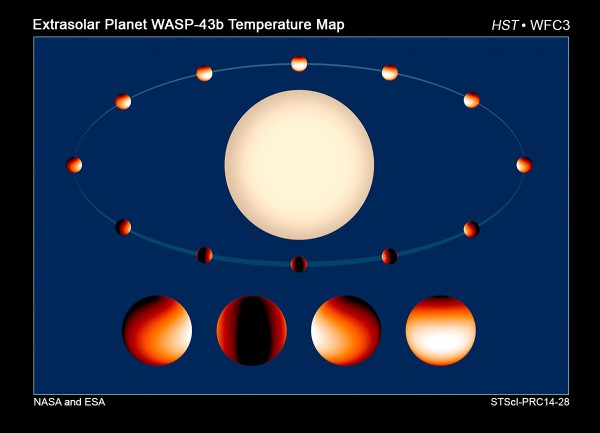Hubble Maps Distant Hot Exoplanet
| Marc Maligalig | | Oct 10, 2014 03:53 PM EDT |
(Photo : NASA/ESA)
A team of researchers from the University of Colorado Boulder used BASA's Hubble Space Telescope to create the most detailed global map of a planet twice the size of Jupiter, hot enough to melt steel and 260 light-years away.
The data from Hubble suggest that the planet, dubbed WASP-43b, is not suitable to be colonized. It is a world of extremes, with its night time coolest temperature at 1,000 degrees Fahrenheit and its hottest daytime temperature of 3,000 degrees Fahrenheit. Both temperatures are hot enough to melt steel.
Like Us on Facebook
The map offers data on the traces the amount and distribution of water on the planet and the temperatures at various layers of the atmosphere. The findings have consequences for comprehending the dynamics of the atmosphere and the genesis of giant worlds like Jupiter, said Jacob Bean, the team leader from the University of Chicago.
"These measurements have opened the door for a new kind of comparative planetology," he added.
There are no surface features such as oceans or continents on WASP-43b that can be used to monitor its rotation as it is a sphere of predominantly hot hydrogen gas, said Jean-Michel Désert, a CU-Boulder assistant professor and the second author of the new study. The gaseous planet's extreme temperature range between nightside and dayside can be used by far-away onlookers to record the passage of time, he said.
"WASP-43b is extreme in many ways," said Désert. "It's the size of Jupiter with twice its mass. Its orbit around its host star, called an orange dwarf, takes only about 19 hours - the blink of an eye compared to the 365 days it takes Earth to orbit the sun."
He also said that the study is enthralling to those aiming to comprehend how planets are formed.
"Basically it is like taking a planet like Jupiter into a giant laboratory, then warming it at such a high temperature that all of the atoms and molecules comprising its atmosphere are in a gas phase."
TagsNASA, Hubble Space Telescope, planet, Gas planet, WASP-43b, Gas giant, Planetary science
©2015 Chinatopix All rights reserved. Do not reproduce without permission
EDITOR'S PICKS
-

Did the Trump administration just announce plans for a trade war with ‘hostile’ China and Russia?
-

US Senate passes Taiwan travel bill slammed by China
-

As Yan Sihong’s family grieves, here are other Chinese students who went missing abroad. Some have never been found
-

Beijing blasts Western critics who ‘smear China’ with the term sharp power
-

China Envoy Seeks to Defuse Tensions With U.S. as a Trade War Brews
-

Singapore's Deputy PM Provides Bitcoin Vote of Confidence Amid China's Blanket Bans
-

China warns investors over risks in overseas virtual currency trading
-

Chinese government most trustworthy: survey
-

Kashima Antlers On Course For Back-To-Back Titles
MOST POPULAR
LATEST NEWS
Zhou Yongkang: China's Former Security Chief Sentenced to Life in Prison

China's former Chief of the Ministry of Public Security, Zhou Yongkang, has been given a life sentence after he was found guilty of abusing his office, bribery and deliberately ... Full Article
TRENDING STORY

China Pork Prices Expected to Stabilize As The Supplies Recover

Elephone P9000 Smartphone is now on Sale on Amazon India

There's a Big Chance Cliffhangers Won't Still Be Resolved When Grey's Anatomy Season 13 Returns

Supreme Court Ruled on Samsung vs Apple Dispute for Patent Infringement

Microsoft Surface Pro 5 Rumors and Release Date: What is the Latest?










